
Newsletter of the College of Heralds of An Tir
Volume 1, Number 4 ~ 26 September 2002


|
The Heralds' Page
Newsletter of the College of Heralds of An Tir Volume 1, Number 4 ~ 26 September 2002 |

|
 From Moræl Black Stag:
From Moræl Black Stag:| Silver Buccle Principal Herald of Æthelmearc |
Black Lion Principal Herald of An Tir |
| Star Principal Herald of Ansteorra |
Goldenwing Principal Herald of Artemisia |
| Aten Principal Herald of Atenveldt |
Triton Principal Herald of Atlantia |
| Crescent Principal Herald of Caid |
Gold Falcon Principal Herald of Calontir |
| Schwarzdrachen Principal Herald of Drachenwald |
Trillium Principal Herald of Ealdormere |
| Brigantia Principal Herald of the East |
Crux Australis Principal Herald of Lochac |
| Beacon Principal Herald of Meridies |
Dragon Principal Herald of the Middle |
| White Stag Principal Herald of the Outlands |
Triskele Principal Herald of Trimaris |
| Vesper Principal Herald of the West |
Editorial notes:
The following is the wording from the grant of arms to Thomas Cathorne in 1553 by Thomas Hawley, Clarenceux King of Arms. A picture of the original grant can be found in "The Art of Heraldry: Origins, Symbols and Designs" by Peter Gwynn-Jones (London, 1998), p. 76. There is also an image of this grant online at: http://www.liripipe.com/sca/scribal/patent2.jpg
| 12. John Flusshe |
Name and Device, New |
|
|
|
Or, a gurges throughout azure, a bordure sable and on a chief vert in dexter a cartouche fesswise argent. John is from Withycombe, E.G., The Oxford Dictionary of English Christian Names, 3rd ed., as a fairly common English 12th - 15th century. Flusshe is from Reaney & Wilson, A Dictionary of English Surnames header Flush, which coincidentally dates John Flusshe to c1405. The cartouche, here, is onomatopoeic. |
|
| 18. Theodore Geisel |
Name and Device, New |
|
|
|
Argent, a pig gules within an orle of eggs vert. Theodore is in Withycombe, E.G., The Oxford Dictionary of English Christian Names, 3rd ed., with this spelling dated 602-690. Geisel is under header spelling Geiseler in Bahlow's Deutsches Namenlexikon, dated 1363. |
|
 Yes, you too can write a letter of recommendation!
Yes, you too can write a letter of recommendation!| Teceangl Bach lions-blood@antir.sca.org tierna@agora.rdrop.com | Seeptember 23, 2002 Send thy comments here: | Brenda Klein 5235 SE Lambert St #A-5 Portland, OR 97206-9068 |
The October Lions Blood meeting will be held on Sunday, October 20th, 1pm, at the home of HL Eglentyne Merryweather, AEstel Herald, in River's Bend. 406 Quail Lane, Longview WA, 98632
Directions: From I-5 take exit 36 Longview/SR 432 and head
west to the exit for Truck Route/Hwy 432. Take that exit and head south
then west along 432 (watch the signs and stay on 432) until the junction
with Hwy 4. Turn right onto Hwy 4 and it's 1/2 mile down on the right
hand side, in Heron Point. There are signs.
The November Lions Blood meeting will be held on Sunday, November 17th, 1pm in the greater Portland area.
Meeting scheduling has gotten interesting lately because Lions Blood's husband
has begun school and cannot travel as he used to. Therefore, most meeting
will be within easy reach of Portland until the term is over. This
does not preclude travel, it just makes distance traveling require more planning
than usual. If you'd like to host a Lions Blood meeting, please contact
Teceangl and discuss arrangements.
FROM LIONS BLOOD HERALD Greetings from Teceangl Lions Blood!
Greetings from Teceangl Lions Blood!
I know, I know, last month's IL proudly proclaimed itself the July Letter. Phooey.
I've been trying to keep up with questions raised in commentary, but I know
these last couple of ILs have been rushed and I might have missed something.
Please don't let it lie; if you have a question and you want an answer and
I missed addressing it in the results from the IL where you asked, email
me or ask again in a future LoC. And remember, you can opine on anything
in the ILs, including the way information is presented and the layout.
This is your tool and I can't make sure it's better unless you tell me what
you want.
The Administrative Handbook of the College of Arms of the Society for Creative Anachronism, Inc., online at http://www.sca.org/heraldry/laurel/admin.html
and which should be in the possession of every branch herald, is unambiguous
about documentation requirements. Section IV.C.2. states:
2. Documentation - Documenting evidence must be included for all name elements and any non-standard armorial elements or practices. Such documentation must include references to specific pages and/or entries in the source material. Except for documentation from items in Appendix H (the No-Photocopy List), such documentation must include copies of cited source material.
Let's clarify. "Copies" means pages with the information on them.
"Appendix H" is the list of only those sources that do not require
copies. ALL OTHER sources, including web pages, must be copied and
sent along with submissions. Laurel has ruled that web sites with URLs
that begin "www.sca.org/heraldry/" do not require copies to be sent to Laurel.
The Academy of Saint Gabriel and The Medieval Names Archive have URLs that
do not begin with www.sca.org/heraldry, therefore any documentation from
those sites must be printed out and sent. The whole article is required,
not just the paragraph with the name. It is important to know what
culture, dates, locations, and other intricacies are involved in the documentation
to know if it is appropriate to the submission in question.
Additionally, the Admin Handbook says "all name elements". All.
Period. Yes, even John and Elisabeth and Mary. Why? Because
names must meet certain rules of consistency; linguistic, temporal, and plausibility.
John is a fine late-period English name, but it would not work in a Russian
name, a Latin name, or a Mongolian name. However, if documentation
supports John in Russia, then the name might be registered in that form.
But without that information neither the An Tir College of Heralds nor the
College of Arms can make that judgment. So include documentation, include
copies of relevant pages from books, include copies of the entire web page
(if it's huge, contact me and I'll help), include the entire letter from the Academy of Saint Gabriel and the entire
email from expert heralds. Use a highlighter and pick out the important
information. Partial information serves no one, but by having all the
needed facts at hand, the Colleges can happily process the submission and
get the client what s/he wants. And isn't that what we're here to do?
(Yes. I'm being irascible. I'm also running out of toner from having to print out so much stuff I shouldn't have had to.)
Certain questions and conflict calls recently lead me to believe it's time
for another run through of my favorite Rule, X.4.j. Changes to Charges on
Charges. I have a love-hate relationship with this Rule because it
offers an easy out for charged ordinaries, but for charges on more complex
charges it requires a re-read every time I apply it. The basic text
is fairly straightforward:
j. Changes to Charges on Charges - Changes to a group of charges placed entirely on other charges may create one clear difference.
No more than one clear difference can be obtained from changes to the same group of charges on other charges.
i. Making two or more visually significant changes to the same group of charges placed entirely on other charges is one clear difference.
So no matter what we do to charges on other charges (tertiary charge groups), we can get no more than one CD for the changes to that group.
Easy enough. Remember that charges on the chief are a different charge
group than charges on the bend and you're halfway there.
Now, what constitutes a change? Reading through X.4.j. it says, "Changes
of type, number, tincture, posture, or independent changes of arrangement
may each count as one of the two changes. Generally such changes must affect
the whole group of charges to be considered visually significant, since the
size of these elements and their visual impact are considerably diminished."
So it seems that anything worth a CD for a charge on the field equals a change.
Right. Changing tincture + number of a tertiary charge group = one
CD. Changing posture + tincture of a tertiary charge group = one CD.
Changing type + orientation of a tertiary charge group = one
CD. Any combination of two changes that get you a CD in the parts of
X.4. above this Rule can get you a CD when applied to a tertiary charge group.
On to the part I love. ii.
In simple cases substantially changing the type of all of a group of identical
charges placed entirely on other charges is one clear difference. Only the
new submission is required to be a simple case in order to benefit from the
following clauses.
(Before we go any further, everyone repeat after me: "There
is NO SUCH THING as 'simple armory'. There is a definition of simple
in X.2. and another completely different definition of simple in X.4.j.ii.,
but there is NO SUCH THING as `simple armory'." Thank you.)
Note that in all cases the charged charge on the field
must be an ordinary, a peripheral ordinary, or another suitable charge.
The Rule defines this requirement: A charge is suitable for the purposes
of this rule if (a) it it simple enough in outline to be voided, and (b)
it is correctly drawn with an interior substantial enough to display easily
recognizable charges. So if you have a gules lion passant on a fess
in the registered armory and a gules martlet on a fess in the submitted armory
you get a CD for the changes to the tertiary charge group. However,
if you have a gules lion passant on a tower in the registered armory and
a gules martlet on a tower in the submitted armory you do not get a CD because
a tower is not an ordinary and is not simple enough in outline to be voided.
I call it a bribe to use ordinaries and other good, period
charges (delfs, lozenges, mullets of five points, etc.) in armory where the
submitter really wants tertiary charges.
FROM THE COVER LETTER TO THE LOAR DATED JUNE 2002:
From Wreath: Daffodils
After reading the discussion provided by the College, it seems appropriate
to rule that the daffodil, like the lotus, has no default posture. The posture
of the flower should be blazoned explicitly, such as affronty or bell to
chief. Daffodils addorsed are daffodils with the bells facing away from each
other.
Daffodils are not slipped and leaved by default. The flower portion of the
daffodil may be referred to either as a daffodil or as a daffodil blossom.
From Wreath: Palls, Shakeforks, and Couped Ordinaries
PRECEDENT: As a general rule, ordinaries couped will be given a CD from ordinaries
throughout. This general rule does not apply to specific ordinaries for which
evidence has been presented that the ordinary and its couped variant were
used interchangeably in period. In accordance with RfS X.4.e, if a particular
ordinary throughout and its couped variant are both found in period armory,
but were not considered to be "separate [charges] in period", no difference
will be granted between them. If the ordinary throughout, or its couped variant,
were not found in period armory, then it will only "be considered different
in type if its shape in normal depiction is significantly different" from
the period form of the ordinary.
PRECEDENT: Because of the period evidence presented concerning pall variants
and in light of RfS X.4.e, no difference will be given between the following
four pall variants: the pall (throughout), the pall couped, the shakefork,
and the pallium. Any of these four charges will be given a CD from a pall
with a decidedly different end treatment, such as a pall fleury or a pall
potent.
From Pelican: Some Issues Regarding the Lingua Anglica Allowance
In the November 2001 Cover Letter, I called for comments regarding aspects of the Lingua Anglica Allowance.
(Certain issues of the discussion in commentary have been removed from this
section by Lions Blood. Please see the cover letter for the full text.)
.... the fairest way address the current issues is to not count the use of
the Lingua Anglica Allowance as a weirdness and to view it as the original
language when examining the name for lingual mixes. This policy upholds the
precedent
We have in the past returned such epithets as Fyrlocc, on the grounds that they didn't follow known period models for English bynames. However, given the recent documentation of Pyrsokomos "flame-hair" as a valid Greek epithet, we are now inclined to permit its lingua franca translation -- but only for names where the original Greek epithet would be acceptable. The submitter will have to demonstrate regular period interaction between Ireland and Greece before this name meets that criterion -- or else show the construction follows period English models. [Fiona Flamehair, R-An Tir, LoAR 05/93]
Similarly, there would be no weirdness for use of the byname of Saxony as a Lingua Anglica version of the German byname von Sachsen.
In the case of William of Saxony, this name would be considered a mix of the English William and the German von Sachsen. As mixing English and German in a name is registerable with a weirdness, this name has one weirdness for the lingual mix. Rendering von Sachsen as of Saxony via Lingua Anglica does not carry a weirdness. Therefore, this name has one weirdness and is registerable.
In the case of Wilhelm of Saxony, the name combines the German Wilhelm with the German byname von Sachsen. Rendering von Sachsen as of Saxony via Lingua Anglica does not carry a weirdness. Therefore, the name has no weirdnesses and is registerable.
In the case of Rhys of Saxony, this name combines the Welsh Rhys with the German byname von Sachsen. As mixing Welsh and German in a name is not registerable, this name is not registerable under the Lingua Anglica Allowance.
To quote Bruce's ruling again, this policy "seems to be the best compromise between the needs of authenticity and ease of use." (March 28, 1993 Cover Letter (January 1993 LoAR), pp. 2-3).
From Pelican: Capitalization of Gaelic Particles: mac versus Mac
A submission this month raised discussion regarding whether capitalization
of particles in Gaelic bynames carried a particular meaning or not. Given
the amount of discussion and varying opinions, a clarification is in order.
Capitalization of name elements in period Gaelic documents was less consistent
than it is now, but it was not completely random. Most sources that reference
Irish Gaelic names use standardized transliteration rules for rendering Gaelic
text. For example, John O'Donovan, Annals of Ireland, by the Four Masters,
is a facing page translation. Each left-hand page is a transcription which
preserves capitalization as it appears in the original work. Each right-hand
page is a 19th C translation of the corresponding left-hand page. The examples
listed below (with 19th C translations) are taken from the year 1400 (vol.
4). A period after a letter indicates a punctum delens (which looks like
a dot that appears above the preceding letter). A punctum delens is usually
transliterated as an h following the letter in question. For example, {m.}
is transliterated as mh. The notation e represents a "long e" character.
In some cases, it is transliterated as e. In other cases, it is transliterated
as ea.
hoiberd mac Emainn mic hoiberd a burc ("Hubert, the son of Edmond, son of Hubert Burke", pp. 768-769)cathbarr {m.}ág aon{g.}usa ("Caffar Magennis", pp. 768-769)
Con{c.}o{b.}ar mac Do{m.}naill mic néill {g.}air{b.}, mic aoda, mic do{m.}naill óicc uí {d.}o{m.}naill ("Conor, the son of Donnell, son of Niall Garv, son of Hugh, son of Donnell Oge O'Donnell", p. 770)
Modern transliteration standards render literal bynames with non-capitalized
particles and family names with capitalized particles. For example, mac Néill
would indicate that this man's father was named Niall, while Mac Néill
would indicate that Mac Néill was his family name. In a period document,
mac Néill could indicate that either that his father was named Niall
or that his family name was Mac Néill.
FROM THE COVER LETTER TO THE LOAR DATED JULY 2002:
From Laurel: KWHS 2003
The 2003 Known World Heraldic Symposium will be hosted by the Barony of Three
Rivers, Calontir (Saint Louis, Missouri), on the weekend of June 6-8, 2003.
From Wreath: Thanks
Well, a year has elapsed since current Team Laurel was warranted, and I wanted
to extend some thanks to people who really deserve it. Thanks to Laurel,
Pelican, and Laurel Clerk for their constant support. Thanks to the Laurel
proofreading squad for contributions semantic, grammatic, and orthographic.
And, of course, thanks to the commenters of the CoA for their research, insights,
and considerable labors.
At this time, though, I'd particularly like to thank those who have been
willing to serve as my personal staff. Thanks to those who have been willing
to suffer through month after month of twelve-hour-long meetings, all the
while contributing opinions, researching issues, finding precedents, locating
possible visual conflicts, and getting much too familiar with three-hole-punch
sheet reinforcers when filing. Thanks to those who have been willing to do
"quick turn-around" research on issues too substantial to be resolved at
the meeting, but which nonetheless had to be fully researched in the short
time between the meeting and first pass proof. Heartfelt gratitude goes out
to Áedán Mac Suíbne, Bruce Draconarius of Mistholme,
Christopher Thomas, Ciaran Cluana Ferta, David of Moffat, Elisabeth de Rossignol,
Francesca Testarossa de' Martini, Rafaella d'Allemtejo, Rouland Carre, Sebastian
Sterne, and Teceangl Bach.
LoARs and cover letters are online at http://sca.org/heraldry/loar/
An Tir results from the LoAR dated June 2002 (see the LoAR for full text):
(typos might exist - only the LoAR itself is definitive; other than name,
action and blazon, listings are paraphrased or abridged)
REGISTERED:
| Ariadne Leontodes |
Name and device. Argent, a Greek sphinx rampant azure winged sable. |
| Blatha an Oir, Barony of |
Device reblazon. Azure, in saltire two daffodils bells fesswise addorsed slipped and on a mount Or a laurel wreath vert. The previous blazon, Azure, in saltire two daffodils slipped and on a mount Or a laurel wreath vert, did not specify the posture of the flowers. |
| Badge reblazon. (Fieldless) Two daffodils in saltire bells fesswise addorsed Or slipped and leaved vert. The previous blazon, (Fieldless) Two daffodils in saltire Or slipped and leaved vert, did not specify the posture of the flowers. |
|
| Brynach ap Rhys |
Name and device. Argent, a dragon salient gules and on a chief engrailed sable a comet argent. |
| Johannes Vagus |
Device. Gyronny of sixteen argent and sable, a salamander statant regardant
gules enflamed Or and a bordure counterchanged sable and Or. |
| Pariselle Chouet |
Device. Bendy sinister and per bend azure and ermine. |
| Richard Falconer |
Name and device. Quarterly azure and vert, a cross gules fimbriated and in canton a falcon Or. Name. |
| Roscelin Silversmith-doghter |
Device. Azure, on a pale between two annulets argent a carnation gules slipped and leaved vert. |
| Tressach mac Domnaill |
Name. |
| Wilrich von Hessen |
Name and device. Per chevron Or and azure, two tau crosses and a horse salient counterchanged. |
| Wolfgang von Bremen |
Name and device. Sable goutty argent, on a chief embattled Or a dragon couchant gules. |
RETURNED:
| None. |
An Tir results from the LoAR dated July 2002 (see the LoAR for full text):
(typos might exist - only the LoAR itself is definitive; other than name,
action and blazon, listings are paraphrased or abridged)
REGISTERED:
| Desiree de Colecestra |
Name. |
| Emma Randall |
Name change from Emma in draumspaka. Her previous name, Emma in draumspaka, is released. |
| Gwenlian Catharne |
Name. |
| Laurin of Rosewood |
Device. Sable, on a rose argent barbed vert a cat sejant affronty sable all within a bordure argent. |
| Randal the Redowtable |
Badge. (Fieldless) A cross formy checky argent and gules. |
| Rhonwen of Rhyl |
Name and device. Sable, on a chief argent a swan naiant wings addorsed issuant from the line of division gules. |
| Roland de Brun |
Name and device. Per pale Or and gules, a griffon segreant contourny argent
maintaining an acorn proper and a sword argent and on a chief sable two crescents
argent. |
| Wlfryð of Leedes |
Name and device. Per pale argent and gules, a wolf rampant counterchanged. |
RETURNED:
| None. |
The following people were present at the July Lions Blood meeting or sent
commentary: Meadhbha inghean Bhriain Mhuilleóir, Ercc mac Fitheal,
Eglentyne Æstel, Sebastian Sterne, Ciaran Goutte de Sang, Teceangl
Lions Blood, Marya Stepanova Kargashina, David Electrum, Christopher Red
Tree, Francesca Dragon's Mist, Frederic Queue Forcheé, Ciar inghean
uí Fhothaidh, Drogo the Forgetful, Antoinette, David of Spinning Winds,
Wenyeva atte grene, Cnut of the Middle, Iago Seagirt, Elisabeth de Rossignol,
A Sombra Pursuivant, Eirik Arbalest, and Gwenlian Catharne.
The following names and armory have been sent to Laurel
(August LoI) --
| Aíbinn ingen Śenáin hui Néill | Name, New |
| Brighid of Guernsey | Name and Device, New | |
| Azure, five crescents in pale argent between two pallets Or. | ||
| Catríona nic Theàrlaigh | Badge, New | |
| (Fieldless) A bee statant proper. | ||
A bee proper has been defined in Laurel precedents: [A bumblebee proper] The bee in this submission is tinctured sable and Or, with argent wings. Bees are sometimes blazoned proper in mundane armory (Papworth, p.957), so there must be a defined tincture --- but none of my sources say what that might be. The coloration of this submission, however, is the SCA's most common attempt at "proper"; I shall henceforth adopt it as the Society's definition of a bee proper. (Aideen the Audacious, September, 1993, pg. 1)The Laurel precedents can be found online at http://www.sca.org/heraldry/laurel/precedents.html |
||
| Davin Steingrimsson | Name, Appeal to Laurel |
| Ealasaid inghean Domhnaill mhic Dhomhnaill, name change from Ealasaid of Madrone | Name, Resubmission to Laurel |
| Geoffrey Fitz Henrie | Name and Device, New | |
| Per chevron throughout sable and gules, a kracken and in chief two broad-arrows inverted argent. | ||
| Gregorio Cristovalez de la Vega | Name, New |
| Hans Dürrmast von der Wanderlust | Badge, New | |
| (Fieldless) A mullet of five greater and five lesser points within and conjoined to an annulet argent. | ||
| Jannet Fletcher | Name and Device, New | |
| Sable, two pallets in pale a moon in her plentitude and two arrows inverted in saltire argent. | ||
| The moon and arrows are the primary charges in this device while the pallets are the secondary charge group. |
||
| Nadezhda Toranova | Badge, New | |
| (Fieldless) A feather per pale Or and sable. | ||
| Wenyeva atte grene | Name, New |
| William Fletcher | Name and Device, New | |
| Argent, in pale a sun in his splendor gules and two arrows inverted in saltire sable fletched between two pallets vert. | ||
| The sun and arrows are the primary charges in this device while the pallets are the secondary charge group. |
||
| Aíbinn ingen Senáin hui Néill |
Device, New
| |
| Purpure chausse Or, within a trefoil knot inverted argent a butterfly Or.removing the compass stars. | ||
Conflict with Damon Annaeus Licinius - July of 2000 (via Meridies). Or, on a pile purpure a thunderbolt argent. There is only 1 CD for change of type and number of tertiary charges. Laurel has ruled on piles versus chausse:[Gules chaussé Or, a seahorse sejant counterchanged] Conflict with ... Or, a pile gules. By long standing precedent, chaussé fields can alternatively be blazoned as having a pile, and both forms must be considered for conflict. Or, on a pile gules, a seahorse sejant counterchanged conflicts with Or, a pile gules, with only one CD for the addition of the tertiary charge. [Samhthann ni Giolla Mhuire, 10/99, R-Calontir] | ||
| Elizabeth Fitzwilliam of Carlisle |
Badge, New
| |
| (Fieldless) On a lozenge azure, a hare sejant argent. | ||
Laurel has made the following ruling regarding charging a lozenge as a fieldless badge:The charges considered media for heraldic display --- the delf, lozenge, cartouche, etc. --- when used in a fieldless badge may not be charged. This ruling has been in force since 1986, and is itself reason enough for return. (Order of the Stella Rubra (Kingdom of Meridies), July, 1993, pg. 14)Which was upheld earlier this year: Note that this does not change our long-standing policy about such “shield shape” charges used in fieldless badges if the tincture is not plain (thus, divided or with a field treatment), or if the charge is itself charges. Such armory will continue to be returned for the appearance of an independent form of armorial display. LoAR April 2002, p. 2 of 33.Therefore, the motif of a fieldless badge of a charged lozenge is not allowed. | ||
| Gemma Meen |
Device, Resubmission to Laurel
| |
| Purpure, on a tower argent a dog rampant vert. | ||
| Conflict with Joe of Rivenstar - April of 1994 (via the Middle): (Fieldless) On a tower argent a cross of Jerusalem vert.
In Gemma's previous submission the dog was ruled to take up enough of the
tower that its placement could not count toward a CD (with type). Unfortunately,
this leaves a single CD for adding the field. Many commenters felt the dog was salient because both hind feet were "on the ground". Wreath Sovereign of Arms has opined that period blazonry considered an animal with its hind legs together salient and an animal with its hind legs apart rampant regardless of whether one foot was lifted significantly. Therefore, we used the term rampant to describe the posture of Gemma's dog. | ||
| Gregorio Cristovalez de la Vega |
Device, New
| |
| Or, five crosses of Santiago in saltire within an orle of ivy gules. | ||
| Commenters found the orle to be drawn too slender and with too many leaves to be readily identifiable as ivy. | ||
| Nels Ulfger i Jaren |
Badge, New
| |
| (Fieldless) On a lozenge vert, a wolf rampant to sinister argent. | ||
Laurel has made the following ruling regarding charging a lozenge as a fieldless badge:The charges considered media for heraldic display --- the delf, lozenge, cartouche, etc. --- when used in a fieldless badge may not be charged. This ruling has been in force since 1986, and is itself reason enough for return. (Order of the Stella Rubra (Kingdom of Meridies), July, 1993, pg. 14)This ruling was upheld earlier this year: Note that this does not change our long-standing policy about such “shield shape” charges used in fieldless badges if the tincture is not plain (thus, divided or with a field treatment), or if the charge is itself charges. Such armory will continue to be returned for the appearance of an independent form of armorial display. LoAR April 2002, p. 2 of 33.Therefore, the motif of a fieldless badge of a charged lozenge is not allowed. | ||
| Wenyeva atte grene |
Name and Device, New
| |
| Per chevron argent and vert, two maple trees couped and a beacon enflamed counterchanged. | ||
| Conflict with Phillip of Ghent - March of 1984 (via Atlantia): Per chevron argent and vert, two fir trees eradicated and a hawk stooping counterchanged. | ||
NEW SUBMISSIONS:
| 1. Agnarr bjarnylr Ásvaldsson |
(Aquaterra) |
Name and Device, New |
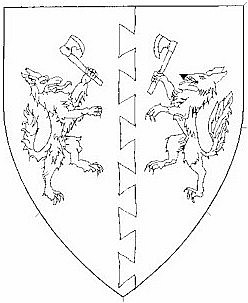
|
Per pale dovetailed argent and azure, a wolf and a fox combatant each maintaining in forepaw an axe counterchanged The submitter will accept minor changes to the name. The submitter desires a male name, and will allow the creation of a holding name. Agnarr is found in Geirr Bassi Haraldsson's The Old Norse Name, pg. 7. bjarnylr is in the same source on pg. 20 Asvald is on page 8 The -r to -s shift is cited from page 17. |
|
| 2. An Tir, Kingdom of, for the North, Principality of | Branch Name, Appeal | |
| Their previous submission
of the same name was returned from kingdom in March 2002 for conflict with
North, the, which has its own entry in the Encyclopedia Britannica and is defined as the part of the United States of America which opposed the Confederacy in the American Civil war. The appeal letter states: "The appeal of the return at kingdom of the proposed branch for the newest An Tir principality "The North" should be considered on the grounds that at the time of the return, Lions Blood was working from a draft copy of the revision of the Administrative Handbook of the College Of Arms of the Society for Creative Anachronism, Inc. which was flawed. The final sentence of section III.A.5 Names of Significant Geographical Locations Outside the Society was missing from the working copy. This sentence reads: "Geographic locations willl generally be considered significant if they appear in standard references such as an encyclopedia. Generic descriptive names outside the Society will not be protected except where the name is immediately associated with a single significant location."Therefore, the real-world placename "North" should not be protected by the SCA College of Arms." The appeal is signed by the Seneschal, Guardian, and Principality Herald of the North. Lions Blood prepared the letter of appeal. Royal signatures for this branch name are on file with Lions Blood. | ||
| 3. Anne d'Amboise | (Aquaterra) | Name, New |
| The submitter accepts minor changes and desires a French female name Anne is found in Withycombe, E.G., The Oxford Dictionary of English Christian Names 3rd Ed., under the header 'Ann, Anna , Anne, Annette, Annie' Anne is listed as the French from, with Anna dated to 1031-1060. Amboise is found as a header in Dauzat et Rostang's Dictionnaire étymologique des noms de leiux en France on pg. 14. | ||
| 4. Angelline d'Avallon |
(Aquaterra) |
Name and Device, New |
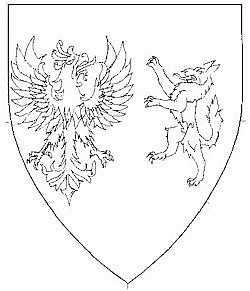
|
Argent a phoenix displayed head to sinister gules and a wolf rampant purpure The submitter accepts minor changes, cares most about the sound, and desires a female name with no requested time period or language/culture. Angelline is cited from "Late Period Female Names from the South of France", by Talan Gwynek, http://www.s-gabirel.org/names/talan/latefrenchfem/. Avallon is cited from "French Names from Two Thirteenth Century Chronicles", by Arval Benicoeur, http://www.s-gabriel.org/arval/names/crusades/crusadesLieux.html. The construction of the byname is also found on this site. "Place names are used as surnames with the preposition de: de + Auberive =d'Auberive" . Hence d'Avallon. Photocopies from both websites are included. |
|
| 5. Appoline d'Avignon |
(Three Mountains) |
Badge, New |
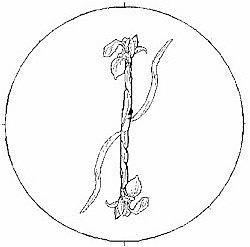
|
(Fieldless) In pale an iris conjoined with another vert flowered purpure. The submitter's name was registered in January 2002 via An Tir. |
|
| 6. Aquaterra, Barony of |
(Aquaterra) |
Badge, New |
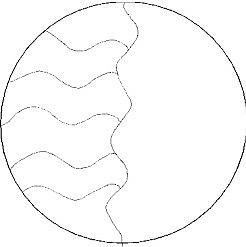
|
Per pale wavy barry wavy argent and azure and vert. The branch name was registered in March of 1983. The form is signed by the Baron. This is meant to be a populace badge. |
|
| 7. Arnora inn harfagri |
(Aquaterra) |
Device, Resubmission to Kingdom |
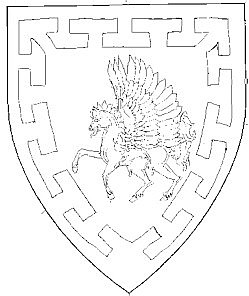
|
Or a pegasus passant and a bordure potent vert. The submitter's name appears on the An Tir May 2002 LoI. Submitter's previous device, Or a unicornate pegasus passant and a bordure potent vert, was returned from kingdom in May 2002 for use of a disallowed charge, a unicornate Pegasus. The redraw solves this problem. |
|
| 8. Arontious of Bygelswade for Consortio de Draconis | (Dragon's Laire) | Household Name, New |
| Submitter's name was registered
in November of 1998. The submitter accepts minor changes, cares most
about meaning and desires a Latin household name. All name elements are taken from Cassel's New Latin Dictionary by D.P. Simpson. MA. (photocopies included): Consortio is cited as 'companionship, community, partnership' De is cited as 'taken from or made from' Draconis is cited as 'a kind of snake, dragon' Each element is tagged "Cic." in the dictionary, indication it was taken from one of the works of Cicero. The meaning the submitter intends is "Community (made) from the dragon". | ||
| 9. Ciarnait inghean Dhonngaile |
(Aquaterra) |
Name and Device, New |
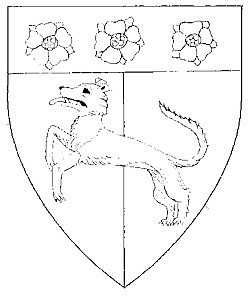
|
Per pale Azure and Vert a wolfhound courant Or and on a chief Or three roses proper. The submitter desires a female name authentic for 12th to 14th century Irish, accepts any changes, and cares most about language/culture. All name elements cited from the Academy of Saint Gabriel Report 1700, http://www.panix.com/~gabriel/public-bin/showfinal.cgi?1700. (photocopies are included). The report was generated for the submitter. The report addresses a late-period Irish feminine name. Ciarnait is one of the forenames suggested in the report, cited from Ó Corráin, Donnchadh, and Fidelma Maguire's Irish Names. inghean Dhonngaile is the suggested patronymic for the daughter of Donnghal. |
|
| 10. Eden Kent |
(Wyewood) |
Name and Device, New |
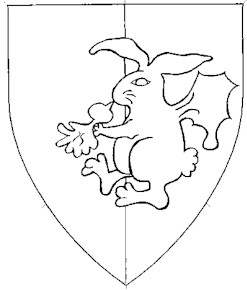
|
Per pale argent and gules, a bat-winged rabbit rampant Or maintaining a radish proper The submitter accepts changes and desires a 16th century English female name. If the name must be changed she cares most about the sound. Eden is cited from Names and Naming Patterns in England 1538-1700, Scott Smith-Bannister, which dates the name to 1550-1559. Photocopies are included. Kent is a header spelling in Reaney, P.H., and R.M Wilson, A Dictionary of English Surnames, pg 263, and dated to 1296 & 1524. The radish is gules with vert leaves. |
|
| 11. Eden Kent |
(Wyewood) |
Badge, New |
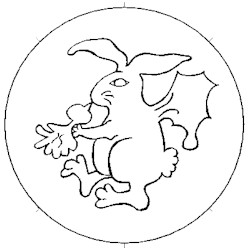
|
(Fieldless) a bat-winged rabbit rampant maintaining a radish Or. The submitter's name appears above. |
|
| 12. Effie Little |
(False Isle) |
Name and Device, New |
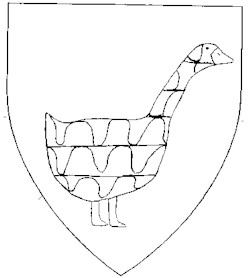
|
Or, a goose vair to sinister. The submitter will accept minor changes and allows a holding name. She claims no preferences of language, culture, time period or gender. Effie is cited from http://www.s-gabriel.org/names/talan/scottishfem/scottishfemlate.html under the header Eufemie, and dated to 1616. Some photocopies are included. Little is cited from "The Clan Little", http://www.Tartans.com/clans/Little/little.html, which states; "In 1398 Nicol Little was one of a group of knights and "squires" entrusted to supervise the repatriation of English prisoners across the border', and 'In 1426 Simon Litill became the 1st Laird of Meikledale being granted tenure of the lands in Ewesdale by James I, King of Scots." Photocopies are included. Tartan sources being what they are, supporting documentation for this byname would be greatly appreciated. |
|
| 13. Eileen in Luch |
(Dragon's Laire) |
Name and Device, Resubmission to Laurel |
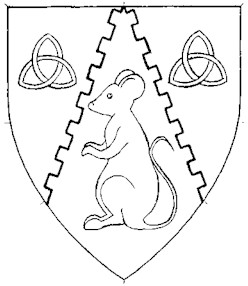
|
Gules, two knots argent, and on a pile inverted throughout embattled argent, a mouse sejant erect sable. The submitter desires a Irish feminine name and accepts changes. If the name must be changed she cares most about the meaning, which is stated to be "'Eileen' the Mouse". Her previously submitted name, Eileen ingen Dubh-luchag was returned from Laurel in December 2001, for lack of evidence for the byname's intended meaning "daughter of shadow-mouse". Eileen is cited from Woulfe, Patrick, Irish Names and Surnames, pg 209. "The name of the mother of Constantine; introduced into Ireland by the Anglo-Normans." in Luch is cited from the May 2000 LoaR in which Crea in Luch was registered without comment . In the minutes of the Caid College of Heralds, December 1999 http://www.sca-caid.org/herald/1999/min 9912.html, it is cited from Malcolm Maclennan's Gaelic Dictionary. An excerpt of email from Talan Gwynek is also included; he states, "The Dictionary of the Irish Language Based Mainly on Old and Middle Irish Materials has no instance of luch as a byname, but it does mention one early instance of the word as a feminine personal name; this seems to me significantly to increase its plausibility as a byname … the one clear instance of an animal byname I've seen uses the definite article..." Luch is also cited from both Pronouncing Gaelic-English Dictionary, Neil McAlpine, pg. 166, and Irish-English Dictionary, Patrick S. Dineen, pg 150. Photocopies of all references are included. Her previous device, Gules, on a pile inverted throughout argent a mouse sejant erect sable, was returned from Laurel on the same LoAR for conflict with Constance Caterine of Padua - Argent chapé gules, two catamounts sejant respectant sable. As chapé and a pile inverted are identical the only CD was for changes to the tertiary charge group. |
|
| 14. Enna van Merebeke | (Aquaterra) | Name, New |
| The submitter accepts minor changes, and desires a feminine name. If the name must be changed, she cares most about the sound. Enna is found in "Dutch Women's Names Before 1100" by Walraven van Nijmege and off the Medieval Names Archive page, direct URL: http://www.geocites.com/athens/1336/name1100vr.html. van Merebeke is found in "Flemish Names from Bruges" by Luana de Grood online at http://www.s-gabriel.org/docs/bruges/, which shows van Merbeke as a byname dated 1555. | ||
| 15. Fáelán Mac Fítheal | (Corvaria) | Name, New |
| The submitter accepts any changes and desires a masculine name. Faelan is cited from Ó Corráin, Donnchadh, and Fidelma Maguire's Irish Names, pg 92, sub Fáelán: "Falelan is a common early name..." Mac is cited from Woulfe, Patrick, Irish Names and Surnames, pg 15 as "son of" Fitheal is also cited from Ó Corráin, Donnchadh, and Fidelma Maguire's Irish Names, pg 104 sub Fíthel. "Fíthel was the name of a brother of Finn Mac Cumaill. Fíthel remained in use amongst the learned family of O Mulconry or Conry by whom it was anglicised Florence and Florry.". | ||
| 16. Fionnghuala Friseil |
(Aquaterra) |
Badge, New |
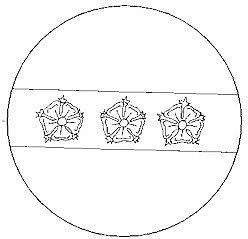
|
Gules, on a fess sable, three roses argent seeded gules barbed vert. The submitter's name was registered in April 1996 via An Tir. She would like assistance documenting this motif to period armory. This badge is to be associated with the alternate name Elsbet Brunnen which appears on the An Tir Letter of Intent dated May 2002. |
|
| 17. Genevieve de Bohun, change from Isolde the Nimble Fingered |
(Blatha an Oir) |
Name and Device, Change |
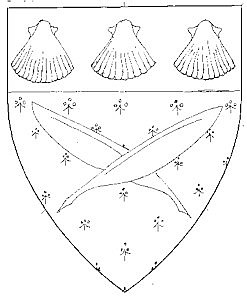
|
Ermine, Two quills in saltire gules. In chief sable three escallops argent The submitter allows minor changes and desires a feminine name. If the name must be changed, she cares most about language culture, which is unspecified, and requests a name authentic for an unspecified time period. Her previous name, Isolde the Nimble Fingered, registered December 1990, and device, Per pale sable and argent an escallop counterchanged, registered December 1990, are both to be released. Genevieve is cited from Lives of the Saints, Richard P. McBrien, pg 64, which says, "Genevieve, patron saint of Paris (ca. 422-ca.500)". de Bohun is cited from The Plantagenet Encyclopedia, Elizabeth Hallum, pg. 33, which dates Bohun, Humphrey de, 8th earl of Hereford to 1276-1322. Photocopies are included for both sources. On the device, the field is ermine, the chief sable, the quills gules and the escallops argent. |
|
| 18. Giovanni Della Rosa | (Aquaterra) | Name, New |
| The submitter accepts minor changes and desires an Italian masculine name. Giovanni is cited from "Italian Names from Florance,1427", on the Academy of Saint Gabriel website at http://www.s-gabriel.org/names/ferrante/catasto/ which shows this spelling as the most common name in the source document. Della Rosa cited from the "Collected Precedencts of the SCA:Documentation", online at http://www.sca.org/heraldry/laurel/precedents/CompiledNamePrecedents/Documentation.html. A precedent of Bruce Draconarius of Mistholme, dated August of 1992, states: The documentation for Delarosa was from Elsdon Smith's New Dictionary of American Family Names, a most untrustworthy source. Delarosa appears to be the Americanized form of the surname; the original Italian would be Della Rosa. The preposition was almost universally separated from the rest of the byname, according to Fucilla. [Name returned since submittor forbade grammatical changes] (Diana Delarosa di Pergola, August, 1992, pg. 23) | ||
| 19. Gregorio Cristovalez de la Vega |
(Dragon's Mist) |
Badge, New |
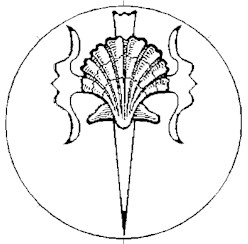
|
(Fieldless) A cross of Santiago Or, overall an escallop inverted gules The submitter's name appears on the August An Tir LoI |
|
| 20. Gunnarr Andreasson | (Aquaterra ) | Name, New |
| The submitter accepts minor changes,
cares more about the stated meaning of the byname, "Anderson", and desires
a male Norse name. The entire name is documented from Geirr Bassi Haraldsson's The Old Norse Name. Gunnarr is found on pg 10. Andreas is found on pg 7. The formation of patronymics is found on pgs. 17-19. | ||
| 21. Kilian van der Meer |
(Aquaterra) |
Name and Device, New |
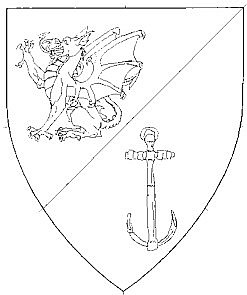
|
Per bend sinister gules and azure a dragon sejant and an anchor Or. The submitter accepts minor changes and lists no preferences for gender, language/culture or time period. Kilian is cited from Bahlow, Hans, Deutsches Namenlexikon, pg. 279, under the header Kilian and dated to the 7th century. Meer (van der) is also cited from Bahlow, as a header on pg. 335. |
|
| 22. Marie Chantes | (Aquaterra) | Name, New |
| The submitter accepts minor changes, and desires a French feminine name. Marie is the submitter's legal middle name. A copy of her Washington drivers' license is included. Chantes is cited as a header from Dauzat et Rostang's Dictionnaire étymologique des noms de leiux en France. | ||
| 23. Mikael Drakelawe | (Aquaterra) | Name, New |
| The submitter accepts minor changes, cares most about sound, and desires a male name. Mikael is cited from Withycombe, E.G., The Oxford Dictionary of English Christian Names 3rd Ed., under the header Michael, dated to 1279. Drakelawe is cited from Ekwall, Eilert, The Oxford Dictionary of English Place-Names, under the header Drakelow, dated to 1175. | ||
| 24. Morgaine Somerset |
(Aquaterra) |
Device, New |
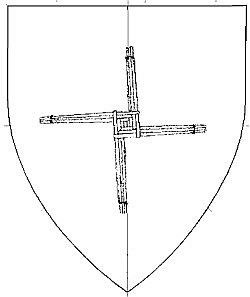
|
Per pale gules and sable, a Brigid's cross argent The submitter's name was registered in June of 2001. |
|
| 25. Morrigan Clubfoot |
(Montengarde) |
Name and Device, New |
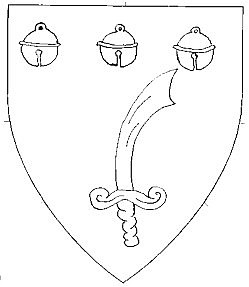
|
(No blazon was submitted - Marya supplied this one.) Vert, a scimitar and, in chief three hawk's bells Or. The submitter accepts any changes, and desires a "10th-15th century Irish or Scottish or Welsh – even English" name. No documentation was included with this submission. An included letter asks that the College assist with finding a name with a similar sound and states that "Morgan is fine, for example." The consulting herald says that the lady realizes she is grasping at straws, but wishes to not lose any opportunity to get a name as close to Morrigan as possible. |
|
| 26. Pedro of Lincolnshire |
(Wyewood) |
Device, Resubmission to Kingdom |
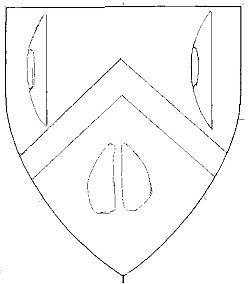
|
Argent, a chevron vert between two bows and a deer's hoofprint gules. The submitter's name appears on the May 2002 An Tir LoI. His previous device of the same blazon was returned from kingdom in May 2002 for a combination of thin bows and a skinny chevron rendering the design difficult to discern. This resubmission addresses the problem by making the chevron 25% wider. |
|
| 27. Rande Dakes |
(Aquaterra) |
Name and Device, New |
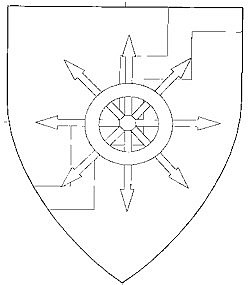
|
Per bend sinister Or and Argent, a bend dancetty Sable, overall an Escarbuncle Gules The submitter accepts minor changes, cares most about the sound, and desires a male name. Rande is cited from Reaney, P.H., and R.M. Wilson, A Dictionary of English Surnames, sub. Rand; Rande de Borham (1299). Dakes is cited from Reaney, P.H., and R.M. Wilson, A Dictionary of English Surnames,, sub. Dakes. No dates are given. (Lions Blood cannot find anything close to Dakes in R&W and requests the College do their best to help out here.) |
|
| 28. Reginleif inn Hárfagri | (Stromgard) |
Name, New |
| The submitter accepts minor changes,
cares most about the meaning of the byname, stated as 'fairhaired',
and desires a female Norse name. Reginleif is cited from Geirr Bassi Haraldsson's The Old Norse Name, pg. 14. inn Hárfagri is also cited from that source, pg. 22. | ||
| 29. Rodrigo Alfonso De Granada |
(Stromgard) |
Name and Device, New |
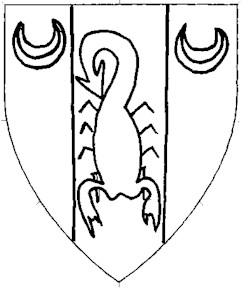
|
Vert, a Pale Or scorpion urinant sable, in dexter and sinister a crescent chiefwise argent The submitter accepts changes and desires a 15th century Spanish masculine name with equal importance to both language and timeperiod. Rodrigo is cited from "Spanish Names from the Late 15th Century" by Juliana de Luna online at http://www.s-gabriel.org/names/juliana/isabella It is also listed in "16th-century Spanish Men's Names" by Elsbeth Ann Roth online at http://www-2.cs.cmu.edu/mnames.html Alfonso is also cited from "Spanish Names from the Late 15th Century", also "A Partial List of Leonese and Castillian Given Names 1050-1200" by Pedro de Alcazar at http://www.s-gabriel.org/names/diego/reilly.html Granada is cited from "Foreign fighters in the war against Granada, 15th c", online at http://marianne.castillo.net/extranjeros_granada.html. The site seems to be used to confirm the period existence of Granada. "This is a list of names of some foreign fighters who participated in the war against the Kingdom of Granada, on the Castillan side." Copies of all websites are included. |
|
| 30. Skapti Thorinsson | (An Tir) | Name, New |
| The submitter accepts changes, cares most about the sound, and desires a masculine name Skapti is cited from Lind, Norsk-Islandska Dopnamn ock Fingerade Namn Fran Medeltiden, column 908. Thorinn is also cited from Lind, column 1179. Thorinsson is cited from Geirr Bassi Haraldsson's The Old Norse Name,, pg 17. Copies from Lind are included, showing the patronymic eponym as Þorinn. CORRECTION: The submitted name should have been spelled Skapti Þorinsson. Lind shows the name Þorinn in column 1179. This correction will published in the October IL. | ||
| 31. Valdis Osborne |
(Aquaterra) |
Device, Resubmission to Kingdom |
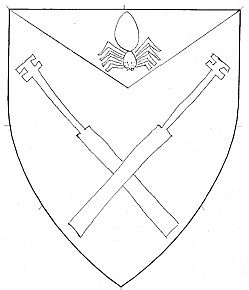
|
Azure, two lacing bobbins in saltire and on a chief triangular argent, a spider inverted azure. The submitter's name and badge appear on the May 2002 An Tir LoI. Her previously submitted device, Azure, two lacing bobbins bendwise sinister and on a quarter argent a spider inverted azure was returned from Kingdom in May 2002 for the use of a charged quarter causing the appearance of augmentation. This resubmission redesigns the device. |
|
| 32. Valentino da Siena |
(Midhaven) |
Name and Device, New |
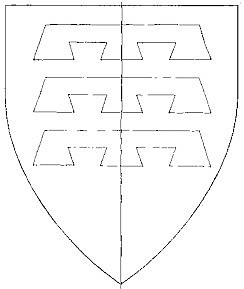
|
Per pale sable and or three labels couped in pale counterchanged The submitter accepts minor changes, cares most about the sound and language, and desires a 14th century Italian masculine name. Valentino is cited from "4300 Citizens of Pisa Swear to Maintian the Alliance with Siena, Pistoia, and Poggibonsi" online at http://library.byu.edu/~rdh/eurodocs/italia/pisani.html, which includes Valentinus, boctarius. The submitter states this to be the Latin form of Valentino. Siena is cited from "Mercator's Place Names of Italy in 1554" listed as a Town/City. This article is online at http://www.s-gabriel.org/names/maridonna/mercator/center.html. |
|
| 33. Valantyne of Roseberry Topping | (Wyewood) |
Name , New |
| The submitter will not accept any changes, and desires a female name. Valantyn is cited from Reaney, P.H., and R.M. Wilson, A Dictionary of English Surnames, s.n. Valentin, and dated to 1327. Roseberry Topping is cited from Ekwall, Eilert, The Oxford Dictionary of English Place-Namel, pg 374. | ||
| 34. Wenyeva atte grene |
(Madrone) |
Device, Resubmission to Kingdom |
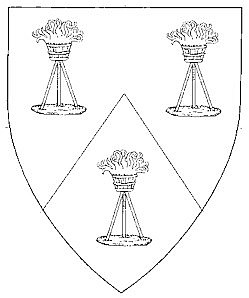
|
Per chevron argent and vert, three beacons enflamed counterchanged The submitter's name appears on the August 2002 An Tir LoI. Her previously submitted device, Per chevron argent and vert two trees and a beacon counterchanged, was returned from Kingdom in August 2002 for conflict with Phillip of Ghent - Per chevron argent and vert two fir trees eradicated and a hawk stooping counterchanged. There is only one CD for change of charge type in the primary group as X.2. cannot apply between types of trees. This resubmission addresses that conflict. |
|
| Written by: Marya Stepanova Kargashina |
 HTML by: HTML by:Lord Anthony Hawke c/o Michael Dowd |